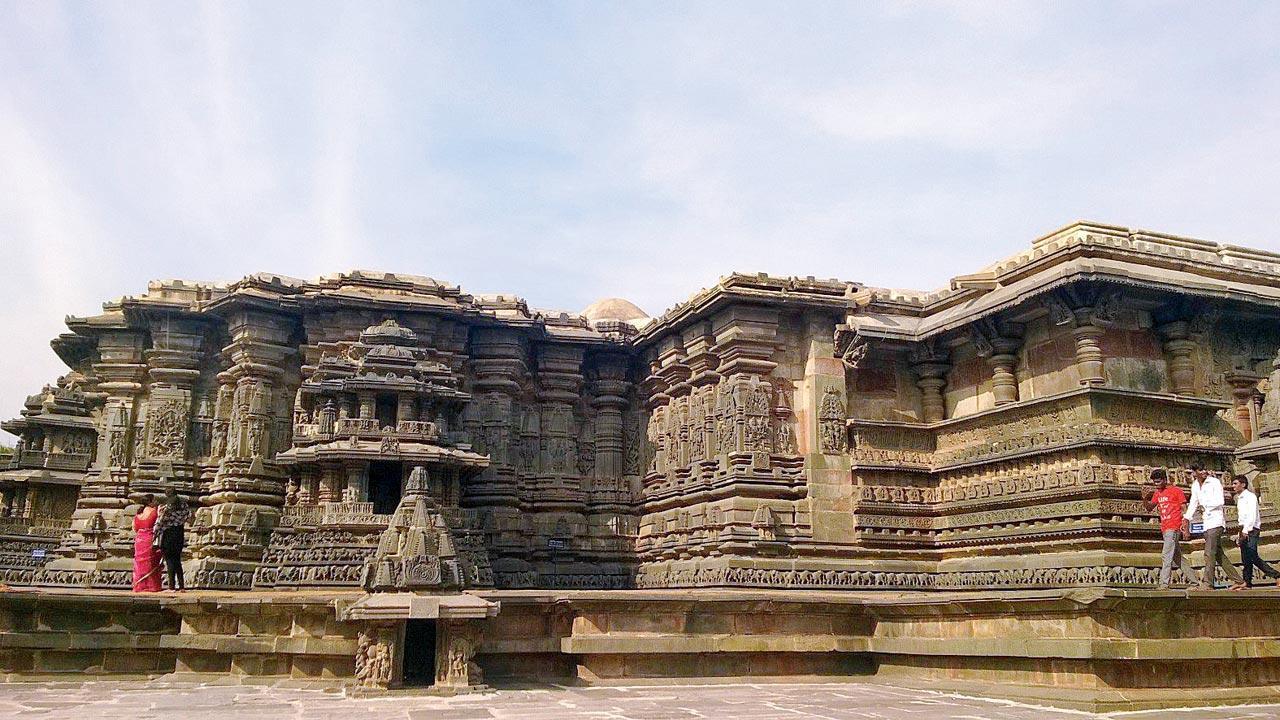Here’s why the architecturally superior ensemble in south-west Karnataka, and India’s 42nd UNESCO World Heritage Site, is worth your while

The Hoysalas used soapstone to carve their temples including the Channakeshava Temple in Belur since it was supposed to be ideal for intricate, detailed carvings
Madame, these stone temples tell stories,” Chenappa MS, the on-site guide at Belur, had said. His words came racing back to this writer’s mind after we learned that the Sacred Ensembles of the Hoysalas —the temples of Channakeshava temple in Belur, the Hoysalesvara Temple in Halebidu, and the Keshava Temple in Somanathapura, were officially inscribed as UNESCO’S World Heritage Site during the 45th session of the World Heritage Committee in Riyadh, Saudi Arabia, on September 18. Belur and Halebidu’s temples were on the tentative list since 2014; all three were officially nominated by the Centre as India’s entry last year.
ADVERTISEMENT
If these destinations have pole-vaulted their way into your travel bucket list, we have good news, especially if you’re a time-strapped traveller. The two sites that we had visited in 2018 (Belur and Halebidu) and a third, smaller site, Belavadi, which isn’t part of the inscription, can be covered in a day. Chikmagalur is the ideal starting point for this trail.
As we drove down the Chikmagalur-Javagal highway, we went past sleepy hamlets, paddy fields and lush topography that our geography-loving travelling companion explained was “because it has a robust groundwater table.”
 Don’t miss the stunningly detailed dwarpalas at the grand entrances to the Hoysaleswara Temple; (right) The Hoysaleswara Temple is considered one of the finest examples to display scenes from Indian epics and mythology. Pics/Fiona Fernandez
Don’t miss the stunningly detailed dwarpalas at the grand entrances to the Hoysaleswara Temple; (right) The Hoysaleswara Temple is considered one of the finest examples to display scenes from Indian epics and mythology. Pics/Fiona Fernandez
Halebidu is a typical temple complex—queues, sprawling lawns filled with picnicking families, an uninspiring ASI (Archaeological Survey of India) museum, and couples posing for pre-shaadi photos. The Hoysalesvara temple was built in AD1121 during the reign of Vishnuvardhana Hoysalesvara. The Shiva temple’s façades are a salute to the sculpting wizardry of artisans who made it resemble 3D imagery. The extensive reliefs include sensuous apsaras, gods and goddesses from the great epics, guardian lions, and elephants, Nandi mandapas, and a mammoth dancing Ganesha at the entrance. Amidst this immersive experience, the odd eyesore offers a reality check—an unaesthetic patch-up job (by ASI) to recreate pillars that had been damaged over time and weather. Still, the high degree of craftsmanship that has survived centuries despite heavy footfalls deserves mention.
Belur (Beluru) was the first capital of the Hoysalas and is home to the Channakeshava temple complex. Its towering façade dramatically emerged against the afternoon sun as we drove into the quaint temple town. Located inside a rectangular complex, it took 103 years to complete (AD 1220). Thankfully, the site’s exteriors were devoid of stalls peddling kitschy knick-knacks that are common across most Indian religious places. Our upbeat mood was short-lived though, after we gave the richly carved façade a closer, longer dekho. Its main gopura was layered with multiple coats of chrome yellow paint! How the ASI, the designated protectors of this site, gave this a nod, we cannot comprehend. This Vishnu temple complex is a heady celebration of symmetrical miniature gopuras, musicians, and courtesans, as well as scenes from the Ramayana and Mahabharata, reminding us of similar detailed panels in Angkor Wat's ensembles. Inside, the massive navaranga platform transported us to a time when devadasis would mesmerise temple audiences with their grace.
On our return, we silently prayed that these bedazzling examples of traditional temple architecture remain in good shape. While their celestial custodians will ably guard it from above, we hope their earthly counterparts ensure that god remains in the details.
Secret find
Closest to Chikmagalur is the Veera Narayana Temple that rises like a stone citadel in the middle of the nondescript settlement of Belavadi. It was built in the trikuta (three-shrined) style in 1200 AD by King Veera Ballala II using soapstone. Belavadi, according to legend, was where Pandava Bheema killed the demon Bakasura, and thus saved the village.
Need to know
Best time to visit: September to early March
Where to stay: Chikmagalur is your best bet with stay options from budget hotels and homestays, to luxurious spaces set in plantations overlooking the Western Ghats.
Nearest airport: Mangalore (152 km). If you have the luxury of time, take the nearly five-hour drive from Bengaluru (270 km) for its scenic, smooth roads
via NH75.
Nearest railway station: Chikmagalur has a railway station with limited connectivity. Hassan (60km) and Kadur (40 km) are the nearest important rail heads.
Want to hear from you
We are looking to visit and write about interesting places of stay and travel, near and far. If you wish to host us for a fair, engaging experience review, write to us at smdmail@mid-day.com
 Subscribe today by clicking the link and stay updated with the latest news!" Click here!
Subscribe today by clicking the link and stay updated with the latest news!" Click here!







